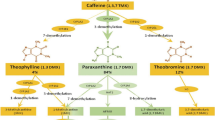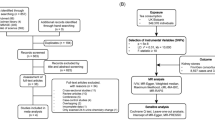Abstract
Objective
To explore the relationship between the consumption of coffee and tea with urolithiasis. We evaluated large epidemiological and small clinical studies to draw conclusions regarding their lithogenic risk.
Methods
A systematic review was performed using the Medline and Scopus databases, in concordance with the PRISMA statement. English, French, and Spanish language studies regarding the consumption of caffeinated and decaffeinated coffee and tea, and the relationship to urinary stone disease were reviewed. Case reports and letters, unpublished studies, posters, and comments were excluded.
Results
As per the inclusion criteria, 13 studies were included in the final review. Most studies, including four large prospective studies and one meta-analysis, reported a reduced risk of stone formation for coffee and tea. Caffeine has a diuretic effect and increases the urinary excretion of calcium, but if these losses are compensated for, moderate caffeine intakes may have little or no deleterious effects. Green and Herbal teas infused for short time had low oxalate content compared to black tea.
Conclusion
There is no evidence that moderate consumption of coffee raises the risk for stone formation in healthy individuals, provided the recommended daily fluid intake is maintained. The currently available literature supports in general a protective role for tea against the stone formation, mainly for green tea. However, heterogeneity of published data and lack of standardization needs to be addressed before final and clear conclusions can be given to patients and to the public in general.

Similar content being viewed by others
References
Curhan GC (2007) Epidemiology of stone disease. Urol Clin North Am 34(3):287–293. https://doi.org/10.1016/j.ucl.2007.04.003
Stamatelou KK, Curhan GC (2003) Time trends in reported prevalence of kidney stones in the United States 1976–1994. See editorial by Goldfarb p.1951. Kidney Intern 63(5):1817–1823. https://doi.org/10.1046/j.1523-1755.2003.00917.x
Rukin NJ, Siddiqui ZA, Chedgy ECP, Somani BK (2017) Trends in upper tract stone disease in England: evidence from the hospital episodes statistics database. Urol Int 98(4):391–396
Letendre J, Cloutier J, Villa L et al (2015) Metabolic evaluation of urinary lithiasis: what urologists should know and do. World J Urol 33:171–178. https://doi.org/10.1007/s00345-014-1442-y
Daudon M, Jungers P, Bazin D, Williams JC (2018) Recurrence rates of urinary calculi according to stone composition and morphology. Urolithiasis. https://doi.org/10.1007/s00240-018-1043-0
Friedlander JI, Antonelli JA, Pearle MS (2015) Diet: from food to stone. World J Urol 33:179–185. https://doi.org/10.1007/s00345-014-1344-z
C. Türk, A. Skolarikos, K. Thomas EAU Guidelines. ISBN 978–94–92671–07–3. http://uroweb.org/guidelines/compilations-of-all-guidelines
Pearle M, Preminger G, Turk T, White JR AUA Guidelines on medical managament of kidney stones (2019). https://www.auanet.org/guidelines/kidney-stones-medical-mangement-guideline
Stang A (2010) Critical evaluation of the Newcastle-Ottawa scale for the assessment of the quality of nonrandomized studies in meta-analyses. Eur J Epidemiol 25(9):603–605. https://doi.org/10.1007/s10654-010-9491-z
Curhan GC, Willett WC, Rimm EB, Spiegelman D, Stampfer MJ (1996) Prospective study of beverage use and the risk of kidney stones. Am J Epidemiol 143:240–247
Curhan GC, Willett WC, Speizer FE, Stampfer MJ (1998) Beverage use and risk for kidney stones in women. Ann Intern Med 128:534–540
Ferraro PM, Taylor EN, Gambaro G, Curhan GC (2013) Soda and other beverages and the risk of kidney stones. Clin J Am Soc Nephrol 8:1389–1395
Littlejohns TJ, Turney BW (2019) Fluid intake and dietary factors and the risk of incident kidney stones in UK Biobank: a population-based prospective cohort study. Europ Urol Focus. https://doi.org/10.1016/j.euf.2019.05.002
Ferraro PM, Taylor EN, Gambaro G, Curhan GC (2014) Caffeine intake and the risk of kidney stones. Am J Clin Nutr 100:1596–1603
Taylor EN, Curhan GC (2009) Demographic, dietary, and urinary factors and 24-h urinary calcium excretion. Clin J Am Soc Nephrol 4(12):1980–1987. https://doi.org/10.2215/cjn.02620409
Massey LK, Sutton RA (2004) Acute caffeine effects on urine composition and calcium kidney stone risk in calcium stone formers. J Urol 172(2):555–558
Goldfarb DS, Fischer ME, Keich Y, Goldberg J (2005) A twin study of genetic and dietary influences on nephrolithiasis: a report from the Vietnam Era Twin (VET) registry. Kidney Int 67(3):1053–1061
Shuster J, Dzegede S (1985) Primary liquid intake and urinary stone disease. J Chronic Dis 38(11):907–914. https://doi.org/10.1016/0021-9681(85)90126-2
Borghi L, Novarini A (1998) Urine volume: stone risk factor and preventive measure. Nephron 81(1):31–37. https://doi.org/10.1159/000046296
Friedlander JI, Antonelli JA, Pearle MS (2014) Diet: from food to stone. World J Urol 33(2):179–185. https://doi.org/10.1007/s00345-014-1344-z
Gambaro G, Trinchieri A (2016) Recent advances in managing and understanding nephrolithiasis/nephrocalcinosis. F1000Research. https://doi.org/10.12688/f1000research.7126.1
Sorokin I, Pearle MS (2018) Medical therapy for nephrolithiasis: state of the art. Asian J Urol. https://doi.org/10.1016/j.ajur.2018.08.005
Heilberg IP, Goldfarb DS (2013) Optimum nutrition for kidney stone disease. Advanc Chronic Kidney Dis 20(2):165–174. https://doi.org/10.1053/j.ackd.2012.12.001
Meschi T, Borghi L (2011) Lifestyle recommendations to reduce the risk of kidney stones. Urol Clin North Am 38(3):313–320. https://doi.org/10.1016/j.ucl.2011.04.002
Rode J, Haymann J-P (2019) Daily green tea infusions in hypercalciuric renal stone patients: no evidence for increased stone risk factors or oxalate-dependent stones. Nutrients 11(2):256. https://doi.org/10.3390/nu11020256
Shu X, Hsi RS (2018) Green tea intake and risk of incident kidney stones: prospective cohort studies in middle-aged and elderly Chinese individuals. Int J Urol. https://doi.org/10.1111/iju.13849
Chen H-Y, Yang Y-C (2018) Increased amount and duration of tea consumption may be associated with decreased risk of renal stone disease. World J Urol. https://doi.org/10.1007/s00345-018-2394-4
Zhuo D, Yao Y (2019) A study of diet and lifestyle and the risk of urolithiasis in 1, 519 patients in Southern China. Med Sci Monit 25:4217–4224. https://doi.org/10.12659/MSM.916703
WU Zhong Biao (2017) Tea consumption is associated with increased risk of kidney stones in Northern Chinese: a cross-sectional study. Biomed Environ Sci 30(12):922–926
Rieg T, Vallon V (2005) Requirement of intact adenosine A1 receptors for the diuretic and natriuretic action of the methylxanthines, theophylline and caffeine. J Pharmacol Exp Ther 313(1):403–409
Nirumand MC, Bishayee A (2018) Review dietary plants for the prevention and management of kidney stones: preclinical and clinical evidence and molecular mechanisms. Int J Mol Sci. https://doi.org/10.3390/ijms19030765
Henning SM, Niu Y, Lee NH, Thames GD, Minutti RR, Wang H, Go VLW, Heber D (2004) Bioavailability and antioxidant activity of tea flavanols after consumption of green tea, black tea, or a green tea extract supplement. Am J Clin Nutr 80:1558–1564
Kanlaya R, Thongboonkerd V (2019) Protective effects of epigallocatechin-3-gallate from green tea in various kidney diseases. Adv Nutr 10:112–121
Jeong BC, Kim BS, Kim JI, Kim HH (2006) Effects of green tea on urinary stone formation in vivo and in vitro study. J Endourol 20:356–361
Itoh Y, Yasui T, Okada A, Tozawa K, Hayashi Y, Kohri K (2005) Preventive effects of green tea on renal stone formation and the role of oxidative stress in nephrolithiasis. J Urol 173:271–275
Arai K, Kodama S (2015) Simultaneous determination of trigonelline, caffeine, chlorogenic acid and their related compounds in instant coffee samples by HPLC using an acidic mobile phase containing octane sulfonate. Anal Sci 31(8):831–835. https://doi.org/10.2116/analsci.31.831
Massey LK, Whiting SJ (1993) Caffeine, urinary calcium, calcium metabolism and bone. J Nutrition 123(9):1611–1614. https://doi.org/10.1093/jn/123.9.1611
Funding
This is an independent study and is not funded by any external body.
Author information
Authors and Affiliations
Contributions
YB project development, data collection, manuscript writing. MC, SD data analysis, BK-S, OT project development, data collection, manuscript editing.
Corresponding author
Ethics declarations
Conflict of interest
None.
Ethical approval
This research is a review paper and does not involve research in humans or animals.
Disclosure
Prof. Olivier Traxer is a consultant for Coloplast, Rocamed, Olympus, EMS, Boston Scientific and IPG.
Additional information
Publisher's Note
Springer Nature remains neutral with regard to jurisdictional claims in published maps and institutional affiliations.
Rights and permissions
About this article
Cite this article
Barghouthy, Y., Corrales, M., Doizi, S. et al. Tea and coffee consumption and the risk of urinary stones—a systematic review of the epidemiological data. World J Urol 39, 2895–2901 (2021). https://doi.org/10.1007/s00345-020-03561-w
Received:
Accepted:
Published:
Issue Date:
DOI: https://doi.org/10.1007/s00345-020-03561-w




